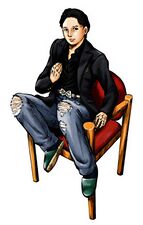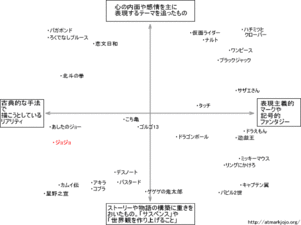Tokai Lecture (June 2006)
Shonen Jump (May 2006)
Interview Archive
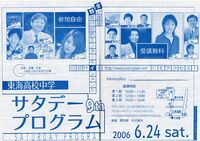
A lecture from Hirohiko Araki titled "Work as a Manga Artist" (漫画家という仕事) at the Tokai Junior High School on June 24, 2006. It was sponsored by Saturday Program (サタデープログラム).[1][2]
Interview
The lecture hall was filled to its 1,500 person capacity. There were so many people that there was a delay while people moved in and out of the hall, and the lecture began 15 minutes later than planned, at 12:45.
12:45: The Lecture Hall
After a student MC introduces Mr. Araki and his body of work, he abruptly pops up on stage, at which time the hall erupts into a deafening round of applause. Mr. Araki, quite nervous at the reception, immediately has a slip of the tongue, saying "I'm a little honored to meet all of you today." "I'm a little... no... quite messed up. I feel like I've met an entire lifetime's worth of people today." Although he claims that he is not a performer, and asks not to expect laughs, he claims "I'm just going to meander along today," scoring some unintentional laughs.
Reason For Accepting The Invitation
Araki, who marks his 25th year as a manga artist this year, used to dislike (from well over a decade ago) being told "I used to read your comics!" "I was a fan when I was young!" etc., since it stirred fears within him that perhaps he was getting old, and becoming irrelevant. But in the past 5 years or so, he has had a gradual change of heart, and has begun to enjoy and appreciate the accolades he gets, especially from older people and people in esteemed positions in society. Also, when he was younger he may have been writing manga to benefit himself and his publisher's bottom line, but now he has a slightly different point of view and wants to give back to people, especially younger people. That's when he got an invitation from Saturday Program, and, figuring it would probably just be a classroom of 30-40 people, he said "sure, I'll do it." However, he arrived today to this circus, and thought, "this wasn't what I signed up for." (audience bursts into laughter)
Motives For Drawing Manga, Family, Days of Youth
Young Araki lived with his father, an office worker, his mother, a stay-at-home mom, and younger identical twin sisters. Those sisters were quite a handful: for example, if there were 3 snacks, the sisters, upon arriving home first, would eat all 3, and then proceed to conceal any traces of evidence. Growing up, young Araki, thinking that there weren't any snacks, "would think 'man, I'm hungry' and go chew on something like a really old piece of kamaboko." (audience bursts into laughter). And when his sisters' evil doings came to light, a fight would erupt; and this would occur on a daily basis. (yet more laughter) He would often feel such a sense of exclusion and ill-will towards his sisters that he didn't want to come home. He used to find relief in spending time alone in his room, reading classic manga from the '70's and his father's collection of art books, which he supposes was his motive for drawing manga. He figures that had he not started drawing manga, he "might have gotten out of hand and killed my sisters." (laughter)
- By the way, in Fuji Television 721's Weekly Shonen Brackets Mr. Araki describes his sisters as "the devil" (laughs).
Days of Submissions and Rejections
He attended a prep school through junior high and high school, but he remembered wanting to become a manga artist after his friend complimented him on the manga he drew (apparently he drew his first manga while he was in 4th grade), due to thinking that he might as well if his very first fan thought he was good. So, he began to secretly draw manga when his parents were not looking. He first began submitting his work during his first year of high school; however, all of his submissions were rejected. At the same time, a rash of artists who were the same age (Yudetamago) or younger than him (Masakazu Katsura) continued to make big splashes with their debut. But Mr. Araki could not understand why he was rejected, and decided to finish off a submission on an all-nighter and go on a 4-hour trip to pay a visit to the editors in Tokyo, and to ask them for an explanation. At first he intended to visit Shogakukan, which published Shonen Sunday, but he was intimidated by the size of their building, and decided to take his submission into the smaller Shueisha building next door. It was noon when he visited, but one rookie editor (about 185 centimetres (6.07 ft) tall) happened to be there, so he showed him his work. However, the editor, after reading the first page, promptly quipped "your white-out's leaked (you haven't fixed it)": he was criticized every time the editor flipped through each page; Mr. Araki, already exhausted from having been up all night, felt like he was going to pass out. However, after he was finished, he was told that it might be good, and was immediately told to fix it up for the Tezuka Awards in 5 days. That submission was "Poker Under Arms", which won was the runner-up prize at the Tezuka Awards.
The Jump Editors At The Time Were Really Scary
At the time, Mr. Torishima (Akira Toriyama's editor, and inspiration for the Dr. Slump character Dr. Mashirito) would take submissions out of their envelopes, glance at the folder, promptly go "I don't want to see this style!" and order a rewrite. Apparently, he wanted people to draw in such a way that looking at the cover was enough to make people want to read the manga. The editorial department as a whole was always on edge at the time. But he also mentioned in the latter half of his lecture that manga editors were like golf caddies; they provided objective information like "why don't you hit this way" or "you're X meters away from the green" and that he appreciated them. He also said that people who wanted to become manga artists had to get along with editors.
Drawing Manga, Araki-Style Part (1): 10 metres (33 ft)
Drawing styles which are so distinctive that you can look at a person from 10 metres (33 ft) away and go, "oh hey, he's reading that manga" are incredible: Araki managed to make his debut, but didn't feel like he had that unique style. And so from 1981 onwards he started thinking about how he could achieve that distinctive style, something that would make people think "oh, that's him!"
Drawing Manga, Araki-Style Part (2): The World's Most Simple Drawing
(Showing a blank piece of paper) If you told your art teacher "this is a drawing of 'snow" he would be very upset at you, but in manga you could say this was "the flash from a nuclear bomb" or "my soul is barren" and that would fly. And here Mr. Araki drops a bomb: "There are people who get paid for stuff like this." (audience bursts into laughter) "It's amazing, really. You know, like....I guess I could get in trouble for mentioning names." (more laughter) [Note: probably in reference to Shaman King, which printed a blank 2-page pullout to supposedly express an "incredible move"] "And coloring the page all black, and saying "he went to hell." Sort of like in the last few chapters of Death Note." (audience goes into hysterical laughter, applause) Mr. Araki tried to patch things up by claiming that he was joking, but could not help further mentioning how much per page said-artists were probably paid for those particular pages.
Drawing Manga, Araki-Style Part (3): The Ultimate Character
Araki introduces modern abstract art such as Barnett Newman's drawing of an orange square on a piece of canvas, Agness Martin's drawing of nothing but a pencil line on white canvas etc. And then he drew the following, calling it the ultimate simple, ideal character in manga anybody could draw:
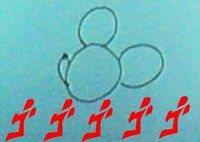
Oh no, we're gonna get sued! "I might get in trouble for displaying this in public, so." (audience bursts into laughter)
He also introduced things like the smiley face and Morizo and Kiccoro (Mr. Araki thought that Akira Toriyama had designed them), and explained that he respected these types of drawings that anybody could recognize, and that it was what he aspired for. "It's incredible. It's the ultimate style."
Drawing Manga, Araki-Style Part (4): Gauguin
Gaugin's art, while having depth, also did things like contain certain colors within certain areas, paint the ground pink and the trees blue etc. Araki loved Gauguin's art ever since he was a child, and has been deeply influenced by him. When Jojo became an OVA, one of the animators asked Araki, "What color is Jotaro?" however Araki had no such concept. He colors everything based on calculation. For example, in Volume 54 Giorno's clothes are pink, but in Volume 63 they are blue. Also, regarding the color cover illustration, he explains that placing the color blue beside pink exudes more power. He says that he gets his inspiration from 80's art, shading techniques in Western art, classical paintings and gets inspiration for his various poses from sculptures. All of this research, blended with Araki's own personality, result in Jojo's art style.
While speaking about the influence of Picasso and Gauguin he also mentioned, "I don't think it's plagiarism when you imitate classics, or from the deceased. But I do think it's plagiarism if you steal or are influenced by people who are currently working [#probably referring to the current event about Western-style painter Yoshihiko Wada's plagiarism accusations. How should I say this, imitation is a form of learning about the classics or like respecting your predecessors."
Drawing Manga, Araki-Style Part (5): Aim & Direction
(Araki shows a diagram[3] mapping the world of manga)
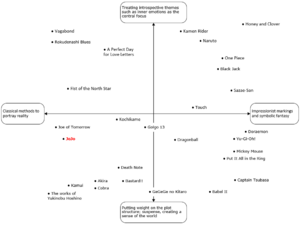
- On the lower left of Kamui is Yukinobu Hoshino, who for some reason is the only person referred to by their name and not the title of their work
If you don't think about "where you stand," you won't have any sense of direction even after you become a manga artist, wandering from idea to idea, not knowing what you want to write about and ending up becoming one of those people who asks their editor, "What should I write?" In the case of Jojo, Araki is trying to pursue reality by portraying things with classical methodology, but he gives precedence to emotion and inner thought over plot structure, trying to portray the protagonists' destiny, so he ends up in the bottom-left quadrant.
Drawing Manga, Araki-Style Part (6): The Theme is "Mystery"
Araki was fascinated by mysteries ever since he was a child, fantasized about deserted islands and believed that King Kong and Nessie existed, and so writes his manga with "mystery" as the central theme. In Jojo, Araki wondered what "superpowers" really were, and if he could portray "energy" itself, which lead to Parts 1 & 2, and the Stands in Part 3, which were like guardians who could "destroy boulders and stuff." They would "stand" by their master and would be called "Stands." Apparently Part 3 began immediately after Part 2 with no interval in between, which was difficult. He exclaimed, "I went, 'Of course I didn't have any characters ready since it just ended, sir!'" (everyone starts a roar of laughter)
Drawing Manga, Araki-Style Part (7): Like an RPG or roll-and-move board game
At the time, the "pyramid (tournament) formula" (A would fight & defeat B, then fight stronger character C, and on and on) was all the craze in Shonen Jump. But, Araki wondered, how strong could they get? Wouldn't the entire system collapse as soon as you reached the top, much like the economic bubble of the 80's in Japan? It wasn't like there could be an infinite number of levels of strength. So, he decided to create an RPG/roll-and-move board game-style system where characters traveled to different places to fight enemies, as seen in Jojo Part 3, where the protagonists traveled across Egypt while battling enemies
Araki's lecture ended here and proceeded to a Q&A with students, which may or may not be posted here as Part 3.
13:38: Araki-sensei's Talk Ends Here
From now on the lecture will be a discussion between Araki-sensei and the students of Tokai Junior & High School. Since there were a lot of questions, they'll be summarized and presented together in a certain order.
Question for Araki-sensei! (1): "When You Were Young, What Was Your Source of Inspiration?"
"Manga, movies... I didn't have any collections; neither did I have any 'solid' objects like plastic models. I enjoyed drawing pictures. I was a boy who wanted to live in a world of fantasy with movies and novels.
(When asked what influenced his works) "After achieving success, respecting my sempai was the most important thing for me. It all started with Da Vinci - reading about such people was very important for me. I learned about the things they mastered, and through their discoveries, I found my own answer.
As for manga I read when I was a boy, the most significant one was Kajiwara Ikki/Nagayasu Takumi's Ai to Makoto (Love and Truth), the scene where the protagonist is stabbed by a knife... although the manga ended in the next issue (a January New Year's double issue), it was still a rather extraordinary experience for me. When I was in middle school, I joined the kendo club because of Tetsuya Chiba's kendo manga Ore wa Teppei (I'm Teppei)."
Question for Araki-sensei! (2): "The Model for Morioh Town, Sendai City"
- Morioh Town is a town in JoJo, while Sendai is Araki's hometown.
"Sendai, when I was a kid, was an old and historical city. Since the '80s, construction began on a new residential district. The new houses were beautiful, but strangers from who-knows-where were scary, and those personal experiences have been tied together with the town itself."
"Well, I don't think there are any homicidal maniacs, but..." (Everyone starts a roar of laughter). Of course, Araki-sensei likes his hometown very much, but he was intimidated by the rapid increase in strangers, maybe Morioh Town was made based on his "disdain" of that situation. Of course, using the real name of the city in his manga may anger people, so Araki-sensei changed the name to something else.
- Also refer to Kahoku Shinpou: Araki Hirohiko's "Daily Expeditions for Buried Gold" and Araki Hirohiko's talk-essay "My Manga are the 'Outcries of my Heart'"
Question for Araki-sensei! (3): "What About Love and Passion?"
Although he went a boy's school, he had a girlfriend. "There's not much to add, since it's what causes the most problems in today's relationships" (everyone starts a roar of laughter).
- By the way, Araki-sensei is married, and according to an interview from Weekly Shonen Brackets, Araki met his first love during his first year in high school, and his preference for the opposite was "a woman who is not ladylike."
Question for Araki-sensei! (4): "What Model Did You Base Your Protagonists On?"
"Eeeeh?" Araki-sensei appears worried. There was no model, but there were influences from "muscle movies" such as "Rambo" and "Terminator." Jotaro Kujo (a character from JoJo) feels like Clint Eastwood: he doesn't run, his movements are minimal and he's a silent person. "On the other hand, the Stands are fast." The personalities of protagonists' from each part are different. After drawing Part I, I wanted to do something I haven't done before. (1st Part: Serious --> 2nd Part: A crazy person)
Question for Araki-sensei! (5): "Is Irene, Gorgeous Irene?"
What is the relationship between Irene of Gorgeous Irene and the Irene who made her appearance in the last part of "JoJo 6" (Stone Ocean Volume 17)?
"I was just having a good time, there is no deep meaning behind it, I'm sorry." (Everyone laughs).
Question for Araki-sensei! (6): "About the Ability of 'Time'"
The most powerful technique: "Time". Stopping it, returning to the past, watching the future... if there were people who can control such a thing, they'd be invincible. For a main character with powers that aren't invincible, I want to have people wonder how such a character could win. The ability to control physical things, such as gravity, is also very powerful.
Araki: About time, when I think about it, it's incredibly powerful. You can do things like repeating the same morning over and over, stopping time while jumping, and the people who become visible only at a particular time, etc. But if I used that concept every time, someone would say: "Is JoJo only about 'time'?" So... (laughs).
Shibasaki: Is it because you're interested in the representation of time?
Araki: It's an interesting and powerful concept. To what extent is it changing? Is the other side of the earth being affected by it as well? And things like that.
Shibasaki: What is the maximum affected range when time is stopped?
Araki: All the way out into space. Speaking of which, what kind of energy would that be?
Question for Araki-sensei! (7): "Joseph Joestar"
And now the 'forbidden question': "Why, as an old man, is Joseph such a lustful man?" "Although JoJo was a story that ended naturally after Part 3, I asked myself: 'Should I draw a 4th part? There shouldn't be anymore Jojo!'" (Everyone laughs). Since I didn't know what would happen in the future, even though I wanted to keep his personality, the personality did match up with his age (Joestar is an old man in Part 4).
Question for Araki-sensei! (8): "Lineage"
When asked about the reason why he's only focusing on the story of the "Joestar family", according to Araki, going back, back, way back, all the way to the origin of the family lineage, his character's lineage gives him a feeling of pride - the wonder and the mystery that exists within the "lineage". "I put more importance on such things than others (said with a serious tone)".
Question for Araki-sensei! (9): "If You Can Describe Manga in A Single Word"
Troubled by the question, Araki replied: "My combined feeling would be 'the salvation of the heart'? I think it's very important."
Question for Araki-sensei! (10): "Western music and its influence"
Using names from Western music to name his characters and "Stands" is a "simple hobby" for Araki. It's also a way to pay his respect towards rock artists. "But the fact that nowadays I'm running out of names of bands to use is becoming a problem". (Everyone starts a roar of laughs). The imitative sounds of Jojo is also influenced by music (This was said on Weekly Shonen Brackets as well). While on the subject, he mentioned that the music of SOUL'd OUT (for whom he had drawn the cover art for their single just a few months ago) is influenced by JoJo. So while "JoJo" is influenced by Rock, it is also influencing "Rock"!
Question for Araki-sensei! (11): "About the Change in Design"
When asked about his designs that continue to change, Araki replied that since he's not trying to draw using classical techniques, the designs won't be the same, and usually experience rapid changes. "I'm not concerned about the old drawings (assertion)." Though the readers may get confused, I wonder if they will forgive me".
- Also included in The Gorgeous Irene: Hirohiko Araki Short Story Collection (Aizōban or Collector's Edition), the illustration of Irene that was drawn for Ultra Jump in 2003[4] seems to be an entirely different person from the original character drawn in 1985. At that time, the comment from UJ PRESS was: "I can't draw in my old style anymore."[5]
Question for Araki-sensei! (12): "You Stopped Drawing Your Self-Portrait"
Often fan letters would ask: "Please make that character appear again", but since that character's story has already ended he did not want a reappearance, and that is all. Although "Baoh the Visitor" ended as though it would definitely continue later, Araki stated that, "I like it as it is." But the Volume 2 Afterword of Baoh the Visitor written by the the writer Baku Yumemakura did say "The continuation of this story is something which will become eventually unavoidable to draw[6]", so... [Note: This Afterword is missing on JoJo's Bizarre Encyclopedia]
Question for Araki-sensei! (13): "If you can describe JoJo in a single word"
To a question that he hates to answer, Araki-sensei's answer was: "'The enigma of human beings', it's something I wanted to draw". As a human who works with a theme that will last for an eternity, that's all. Moreover, the manga is also being drawn for people who have committed crimes, it will make them think: "How did I become like this? Is there a meaning in this existence?" It's an "ode to humanity".
Conclusion
And so the time has come, the last words from the moderator, and the falling of the curtain. The clock says it is 2:05 PM on June 24, 2006. An event of about 1 hour and 20 minutes long, but to Araki's fans, without a doubt it was a "golden personal experience." Escorted by applause heavy as thunder, Araki-sensei disappeared behind the curtain with a smile on his face.
- End -
[Translated by Neuroretardant (Lecture and Manga Diagram)[7][8], Xibanya (Manga Diagram)[9], and Aldo (Q&A Session)[10]]
Gallery
References
- ↑ http://atmarkjojo.org/archives/1194.html
- ↑ http://wba.sakura.ne.jp/report/satpro/index.html
- ↑ Recreation of Tokai Lecture (June 2006) Manga Diagram by SHATO from Atmarkjojo.org
- ↑ Ultra Jump 2003 Issue #1 - Irene Rapona (Poster)
- ↑ Ultra Jump 2003 Issue #1 - Jolyne Cujoh & Irene Rapona (UJ PRESS)
- ↑ Writer Baku Yomemakura Talks About the Charm of JoJo, Which Both Parent and Child Go Crazy Over
- ↑ Hirohiko Araki Lecture Part 1: His Past & Motives
- ↑ Hirohiko Araki Lecture Part 2: Drawing Manga, Araki-Style
- ↑ Translation of Tokai Lecture (June 2006) Manga Diagram by Xibanya from somethingawful.com
- ↑ Hirohiko Araki Lecture Part 3: Questions and Answers with Araki-Sensei
